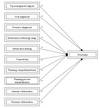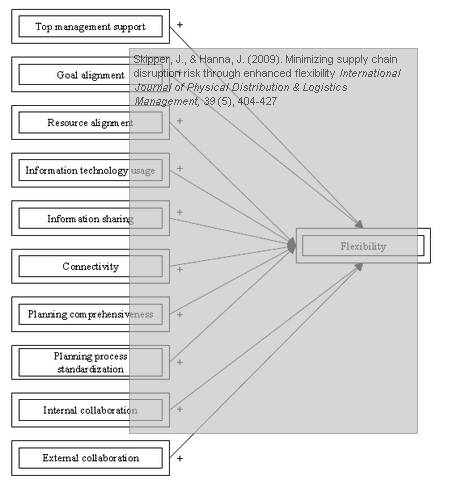 Can contingency planning increase flexibility and minimize risk exposure to supply chain disruptions? Obviously yes, but what is it about the contingency planning process that relates to flexibility? That question is asked by Joseph B Skipper and Joe B Hanna in Minimizing supply chain disruption risk through enhanced flexibility. Surprisingly, this article suggests that only very few variables of contingency planning are positively related to flexibility…puzzling, isn’t it?
Can contingency planning increase flexibility and minimize risk exposure to supply chain disruptions? Obviously yes, but what is it about the contingency planning process that relates to flexibility? That question is asked by Joseph B Skipper and Joe B Hanna in Minimizing supply chain disruption risk through enhanced flexibility. Surprisingly, this article suggests that only very few variables of contingency planning are positively related to flexibility…puzzling, isn’t it?
Flexibility
Why contingency in supply chains? Isn’t flexibility enough? While flexibility is often associated with simply being responsive or adaptive to customer preferences or quick to change to new markets, it also carries with it
the ability to encounter, resolve and exploit an unexpected emergency or opportunity
Flexibility thus becomes a strategic capability. This capability can be enhanced through contingency planning, but not all attributes of the contingency planning process contribute equally to the overall supply chain flexibility.
Contingency planning
Supply chain flexibility is what makes it possible to respond to an unpredicted and unexpected disruptive event in a successful manner. Since it is impossible to predict the exact nature and extent of disruptive events, the response must be generic and open-ended, in other words “flexible” or “contingent”. Contingency planning is thus a key strategic tool to achieve flexibility, as LaLonde writes in his 2005 essay on “Fiddling while Rome burns“:
Contingency planning is a special type of planning that provides a blueprint for responding to the risks associated with an unknown event. The contingency plan document should detail a timely and complete response to a specific risk or a cluster of risks. The specific processes embedded in the plan would depend on the nature of the risk. For example, the risk assessment for a retail operation would likely differ from that of a manufacturer or a transportation company. In general, the process part of the plan should include the following elements: risk assessment, risk evaluation and management, first response, collaborative management, subsequent stages of response, security, operations, stability, and performance evaluation.
While the “fiddling” obviously eludes to the alleged story that the Roman Emperor Nero was playing the fiddle while his capital city burned in AD64, there is a pun to it, as in fiddle = alter, adjust, or change in minor ways without any meaning, essentially: not doing what you were supposed to do, namely responding properly to the burning of the city. Here, a proper contingency plan will help eliminate the fiddling. Contingency planning is a risk management tool.
Hypotheses
The authors identify 10 contributing factors in the contingency planning process and test for whether these factors are positively related to flexibility.

Top management support. Without continuous commitment, support, patience and leadership from management, not much will develop in the lower ranks.
Goal alignment. The strategic goals must be aligned through strategy documents, corporate values, rules, procedures and resource allocation.
Resource alignment. Inter- and intra-organizational resources, if coordinated and aligned can increase flexibility.
Level of IT usage. Information Technology can assist an organization’s ability to generate, combine, capture, process and analyze various streams of information that vital to its survival.
Level of Information sharing. A successful planning process requires the willingness to make strategic and tactical data available across the supply chain.
System connectivity. Following Information technology and information sharing is the ability to connect and integrate different systems, facilitating seamless data exchange.
Comprehensiveness. This is only possible to achieve through an extensive evaluation of objectives and alternatives, risks and benefits at all levels of decision-making, throughout the organization.
Standardization. This entails the establishment of common policies and procedures, thus providing consistency in the way situations are handled.
Intra-organizational and inter-organizational collaboration. True collaboration will result in joint knowledge creation, sharing of expertise and understanding each others intention and strategic approaches to different situations.
Result
The result is – to my mind – perhaps a bit disappointing. Only these four factors in the contingency planning process are positively related to flexibility, according to the regression analysis of the survey performed by the authors:
- Top management support
- Resource alignment
- Level of IT usage
- Inter-organizational collaboration
Interesting. I would have expected more or all variables to be of importance in contingency planning for flexibility. At least, I would have thought so, judging from a seemingly complete review of supply chain flexibility literature in Babu and More (2008), and even more so from the discussion of the enablers of risk mitigation in Faisal et al. (2006)
Conclusion
It took me some reading to fully comprehend the message of the article. It is not supply chain flexibility that is center stage here. It is the contingency planning process…applied in a supply chain setting, aimed at generating flexibility from within. And is not the contingency plan that makes a supply chain flexible, it’s the contingency planning process that is important. As Dwight D. Eisenhower is supposed to have said
The plan is nothing, planning is everything.
If you have learned how to steer (through the planning process), you will be able to steer and navigate even in treacherous waters, applying flexibility where it is needed.
Reference
Skipper, J., & Hanna, J. (2009). Minimizing supply chain disruption risk through enhanced flexibility International Journal of Physical Distribution & Logistics Management, 39 (5), 404-427 DOI: 10.1108/09600030910973742
Author links
- linkedin.com: Joseph B Skipper
- auburn.edu: Joe B Hanna
Related
- husdal.com: Risk disablers
- husdal.com: Supply chain flexibility – literature review












